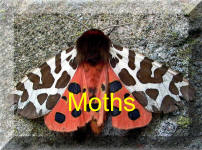1991 Elephant Hawk Moth Delilephila elpenor
Back to

Family: Sphingidae: Macroglossinae
Wingspan: Approximately 70 mm wingspan
Distribution: Found throughout most of England, Wales and Ireland. In Scotland they are mainly found in the south and west.
Months seen: May to July. Caterpillars are seen from July to September.
Habitat: Gardens, woodland clearings. and waste ground
Food:
Adults: Honeysuckle, rhododendron and other nectar-rich flowers.
Larvae: Rosebay willowherb(Chamerion angustifolium), great willowherb (Epilobium hirsutum), marsh bedstraw (Galium palustre), fuchsia and many other plants.Description
The large elephant hawk-moth is one of our more brightly coloured moths with bright pink wings and body, and tinges of olive green and brown.. It gets its name from the caterpillar which has a trunk-like snout. The caterpillars, which are seen July to September, are blackish brown,or sometimes green, and have a black horn at the end.When it feels threatened it draws this snout in, towards its body. This has the effect of inflating its head, which features four large eye markings.When the caterpillar is fully grown it moves down to the ground to pupate. It remains in it's cocoon until next spring (around May) when it emerges as an adult moth. The Moth Flies at Night searching for night scenting flowers. They grow to 7cm long. The caterpillars reveal two large eye spots near the front, particularly when resting, which gives them a dangerous look, They feed on willowherbs at night, but are often found hiding among leaves during the day.

